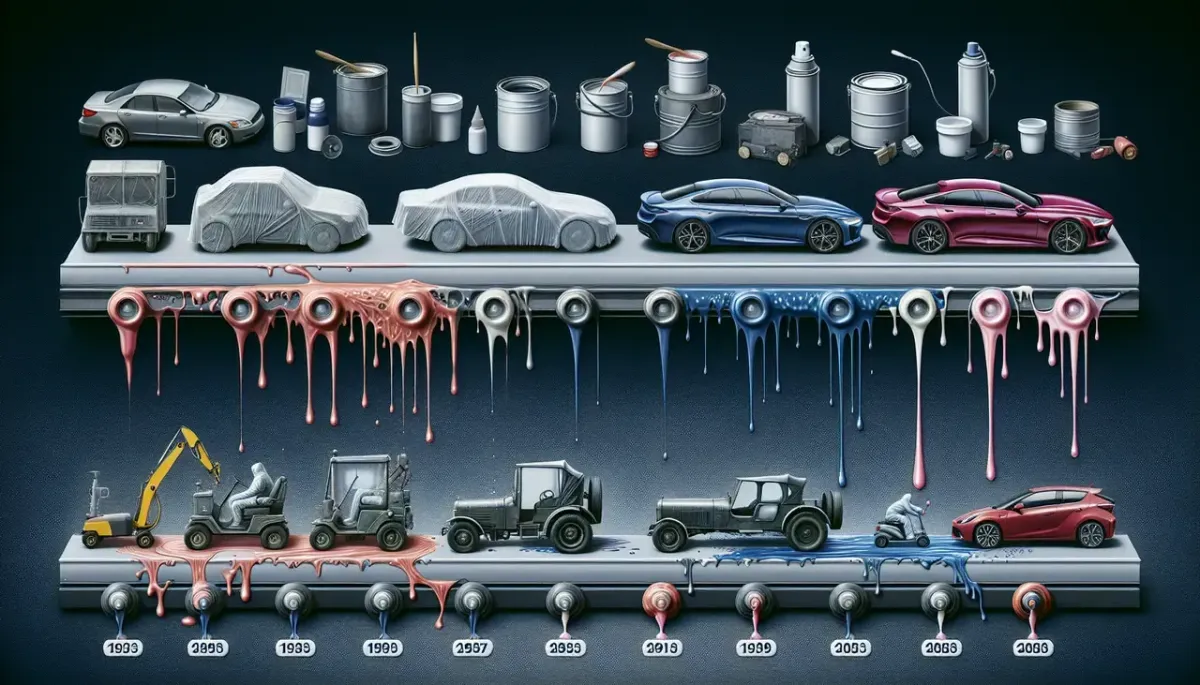My Awesome Detailer, LLC
My Awesome Detailer, LLC's Blog
"Auburn Alabama's #1 Resource for Ceramic Coating & Auto Detailing Information"

The Evolution of Protective Car Coating Technology: From Past to Present
Introduction to Protective Car Coating
Cars are not just vehicles; they're investments and part of the family. Protecting them from scratches, weather, and time is where protective car coatings come in. Think of this coating as a shield. In the beginning, we had wax. Simple, straightforward, but not very durable. It needed frequent reapplication. Then came sealants, a step up, offering better protection and lasting a bit longer. But the real game-changer has been the advent of ceramic coatings. These coatings can last years, not weeks or months, providing a level of protection against UV rays, scratches, and chemical stains that was unheard of in the past. They create a hard, protective layer over your car's paint, making it easier to clean and keeping it looking new longer. The evolution of protective car coatings has been about finding better ways to keep cars safe from the elements and looking great without constant upkeep.

The Origins of Protective Car Coating Technologies
The journey of protective car coating technologies began as a means to tackle rust and corrosion, problems plaguing vehicles since their invention. Originally, car owners used rudimentary methods such as applying greases and waxes to shield their vehicles from moisture and dirt. In the 1950s, things changed significantly with the introduction of more advanced polymers and chemicals. These substances offered cars a stronger, more resilient barrier against environmental damages.
Technological advancements led to the development of ceramic coatings in the late 20th century. This innovation provided cars with a durable, high-gloss finish, offering enhanced protection against scratches, UV rays, and chemical stains. Unlike the previous solutions, ceramic coatings bonded at a molecular level with the vehicle's paintwork, offering long-term protection that was less about frequent reapplication and more about steadfast durability.
In essence, the origins of protective car coating technology were all about finding solutions to preserve the car's aesthetic value and structural integrity. From simple waxes to sophisticated ceramics, each step in this evolution has aimed to deliver better protection, ease of maintenance, and overall vehicle longevity.
Breakthroughs in the 20th Century
The 20th century was a turning point for car protective coatings. It all kicked off with simple wax-based formulas. These early attempts provided cars with a basic level of shine and minimal protection against the elements. But as cars became more integral to daily life, the demand for more durable solutions drove rapid innovation. By the mid-century, technology had advanced to synthetic sealants. These sealants offered better protection than wax against UV rays and environmental pollutants, marking a significant step forward. Then, in the 1980s, something game-changing happened: the introduction of polymer coatings. These weren't just an improvement; they revolutionized car protection. Polymer coatings formed a stronger, more resilient barrier against scratches, chemicals, and weathering. As we closed out the 20th century, the stage was set for the future of car care—coatings that not only protect but also enhance a car's appearance for years. This era laid down the foundation for the sophisticated, nano-technology-based solutions we see today.
The Role of Nanotechnology in Modern Coatings
Nanotechnology has changed the game in car coatings, making them tougher and longer-lasting than ever. By working at an incredibly small scale—measuring in nanometers—scientists can improve the chemical properties of coatings. This means your car not only gets a shiner finish but also a shield that's much better at keeping away scratches, UV damage, and dirt. Imagine tiny warriors, invisible to the naked eye, guarding every inch of your car's surface. That's nanotechnology at work. It doesn't just stop at making your car look good; it also makes maintenance easier. Water, dirt, and grime slide off effortlessly, meaning less time spent on cleaning and more on enjoying the ride. In a nutshell, thanks to nanotechnology, modern coatings are not just about aesthetics; they protect your ride against environmental aggressors, ensuring it stays newer for longer.
Types of Protective Car Coatings Available Today
When it comes to safeguarding your car's appearance, protective coatings stand at the forefront. Nowadays, a range of options is available, each with their unique benefits. Let's break them down:
Ceramic Coatings leap ahead with their durability and hydrophobic properties. Applying this liquid polymer creates a chemical bond with your car's paint, resulting in a long-lasting barrier against the elements. It's great for resisting scratches, dirt, and water, offering protection that can last up to five years, or even more with proper care.
Polyurethane films, often known as clear bras, are another popular choice. These films are essentially invisible and wrap around your car’s body, guarding against stone chips, scratches, and the wear of daily use. They’re highly flexible, making them suitable for various parts of your vehicle.
Glass Coatings bring a unique approach, offering a layer of silica-based or quartz-silane-based compound. They provide a glossy finish that also repels water and contaminants. Glass coatings are known for their exceptional durability and resistance against environmental impacts.
Graphene Coatings are the new kids on the block, boasting advancements in technology. Graphene offers a harder, more chemically resistant surface than ceramic coatings. It’s praised for its heat dissipation qualities, reducing the amount of heat absorbed by the car’s surface.
Choosing the right protective coating hinges on your needs. Whether you prioritize longevity, aesthetics, or specific protective traits, there's a solution that fits. Remember, while protective coatings shield against many harms, regular maintenance is key to keeping your car in tip-top shape.
Comparing Ceramic Coatings with Traditional Wax
When we talk about protecting your car's paint, you're likely thinking of either ceramic coatings or traditional wax. Traditional wax has been the go-to for years. It's easy to apply, gives your car a nice shine, and offers basic protection against the elements. A good wax job might hold up for a few weeks or even a couple of months if you're lucky. On the flip side, ceramic coatings are like wax on steroids. They not only give your car a glossy sheen but also provide a robust layer of protection. This means your car's paint is shielded from UV rays, bird droppings, dirt, and even minor scratches. A ceramic coating can last for years, not just weeks or months. Yes, it's pricier upfront and needs a professional to apply it, but think of it as investing in your car's future good looks and health. So, if you're weighing short-term savings against long-term protection, ceramic coatings have the edge. You decide what's best for your ride.
The Environmental Impact of Protective Coating Development
The journey of protective car coatings has always been closely linked with environmental concerns. Initially, these coatings relied heavily on chemicals that were harsh on the environment, releasing volatile organic compounds (VOCs) into the air. These compounds contributed to pollution and were a threat to both the atmosphere and human health. However, as awareness grew, the industry began to shift. Manufacturers started exploring eco-friendly alternatives that promised the same level of protection without the detrimental environmental impact. Today, there's a significant move towards water-based coatings. These are not only safer for the environment by greatly reducing the emission of VOCs but also for the workers applying them, offering a healthier workspace. Additionally, the development of longer-lasting coatings means vehicles need to be recoated less frequently, further reducing the environmental footprint. This evolution demonstrates the industry's commitment to balancing protection with environmental responsibility.
Maintenance Tips for Modern Protective Coatings
To keep your car’s protective coating in top shape, you don't need to be a car expert. Just stick to a few simple routines. First, wash your car regularly. Dirt and grime build-up can wear down any protective coating over time. Use a mild, pH-neutral soap to prevent the coat from getting damaged. Avoid harsh chemicals at all costs. Secondly, waxing is out. Modern coatings don’t need wax to keep their shine. In fact, wax can interfere with how these coatings perform. So, ditch the wax and enjoy the low maintenance. Lastly, watch where you park. Although these coatings protect against a lot, parking under trees or near industrial areas can expose your car to stuff like bird droppings and acid rain that can weaken the protective layer. So, find a safer spot. That’s mostly it – clean gently but regularly, skip the wax, and park smart. Stick to this, and your car’s coat will keep turning heads for years.
Future Trends in Protective Car Coating Technologies
Car coating technology isn't slowing down; it's set to get even more impressive. We're moving towards materials and methods that could heal scratches on their own, imagine your car fixing its own scratches like magic. There's also buzz around coatings that could last the lifespan of the car. No more reapplying every few years, just one and done. Eco-friendly options are on the rise too, with scientists developing coatings that are less harsh on our planet. Imagine a coating that helps clean the air. Lastly, we might see coatings that change color based on temperature or mood. Your car could match your vibe any day. The future looks bright, and your car's going to shine in ways we’ve just started to imagine.
Conclusion: The Continued Evolution of Car Protection
As we steer through the journey of protective car coating technology, it's clear that innovation doesn't hit the brakes. From the early use of wax to safeguard the shininess and integrity of a car's paint, to the advanced ceramic coatings that offer a shield against scratches, UV rays, and chemical stains, the evolution is impressive. This forward march in technology ensures that car owners today have access to protection that's not just more durable but also more efficient and easier to maintain. The future promises even more advancements, with research diving into nanotechnology for even tougher and longer-lasting protection. The aim is to keep our cars looking newer for longer without the constant need for reapplication or repair. As car lovers, it's an exciting time to watch and benefit from the continued evolution of car protection.

My Awesome Detailer was founded with one mission: to bring elite-level vehicle protection and detailing to Auburn, AL and beyond.
Since day one, our focus has been delivering long-lasting paint enhancement, value retention, and top-tier appearance protection —with zero compromises.
We believe that true automotive care starts with clear communication and customized solutions, tailored to the specific needs of each vehicle and owner. From professional-grade ceramic coatings and self-healing paint protection film to precision paint correction and full-vehicle detailing, every service we offer is designed to elevate, protect, and preserve your investment.
At My Awesome Detailer, you don’t just get a clean car—you get long-term peace of mind and a finish worthy of a showroom spotlight.
Contact Info & Address
2709 Frederick Road, Opelika AL 36801
(334) 650-6499
Working hours
Monday: 8am-5pm
Tuesday: 8am- 5pm
Wednesday: 8am - 5pm
Thursday: 8am - 5pm
Friday: 8am - 5pm
Saturday: 8am-5pm
Sunday: Gone Fishin'
All Services by Appointment Only
Map
@ 2025 Copyright. MAD, LLC All rights reserved.
